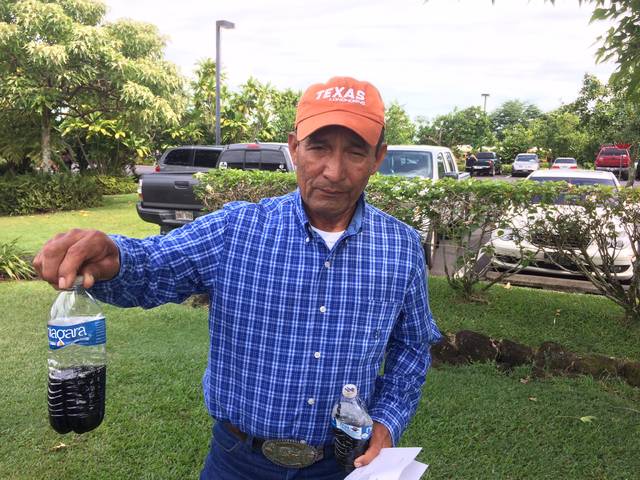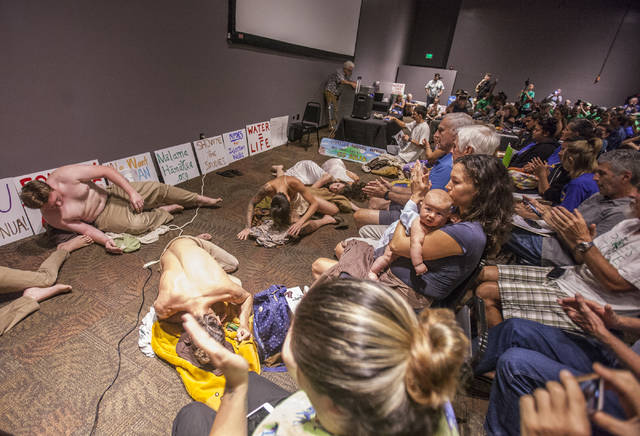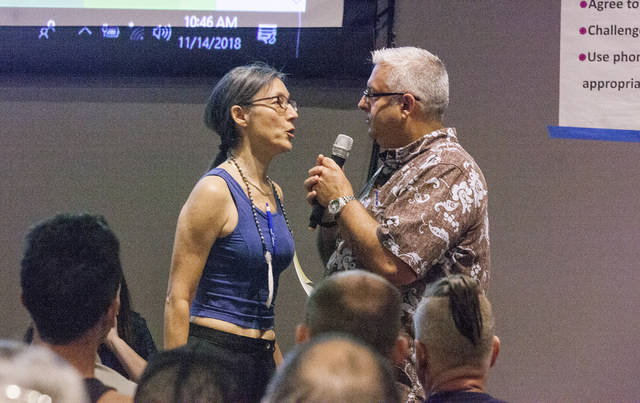HILO — Citing concerns over air and water pollution, opponents of the Hu Honua Bioenergy power plant — being built along the coast near Pepeekeo — asked during a hearing Wednesday that an environmental impact statement be done before the project is complete.
The hours-long hearing at ‘Imiloa Astronomy Center in Hilo focused on the biomass project’s storm water discharge and water injection well permits. It followed an informational meeting in the morning that was at times raucous and punctuated by outbursts from audience members, as a moderator struggled to maintain control.
The hearing in the afternoon was more civil but remained colorful. It included testimony from dozens of Hamakua residents on both sides of the issue, students concerned about environmental impacts, and one group that expressed its opposition through dance.
Gary Harrold of the Sierra Club, Moku Loa Group, said the project would impact nearshore resources through contaminates or thermal pollution. He ended his testimony by holding a sign that read, “Hu Honua means more dead fish.”
While the topics of the meetings were the injection and storm water permits, critics also took aim at the project’s credibility as a renewable energy project, its affect on greenhouse gas emissions and its impact on utility rates.
“There’s too much at risk here,” said Maurice Goldman. “This is not a carbon-neutral project. We’re not even getting cheaper electricity.”
Supporters said the project would bring jobs to the former plantation community. They thought environmental concerns were being exaggerated.
“You can’t change what is true,” said Lorraine Mendoza of Pepeekeo.
“… Communities are meant to be built, not be divided.”
Gilbert Demotta, a former Pepeekeo plantation worker, was more blunt.
“A lot of you are lying,” he said. “If you’re lying, we don’t need you here.”
During a question period following the information meeting, Linda Lincoln of Pepeekeo said there needs to be an environmental assessment or impact statement to help the community understand the risks. That request was repeated throughout the day.
“There’s going to be so many unanswered questions,” she said, adding she didn’t trust the company to monitor itself.
State Department of Health officials said there wasn’t a trigger for an EA or EIS under the state’s environmental laws. Those can include use of public lands or public funds.
Warren Lee, Hu Honua president, told the Tribune-Herald the project might not have triggered the review because the property is zoned industrial and was previously used as a coal-fired power plant during the plantation days.
Hu Honua, which is doing business as Honua Ola, has a power purchase agreement with Hawaii Electric Light Co. for 21.5 megawatts of electricity. The power would be generated by burning wood chips from eucalyptus trees harvested on the island, which would create steam.
‘A black river’
The $250 million project is facing criticism not just from its neighbors.
Dave Clark, a laborer from Waimea who is working at the job site, said he witnessed a “black river of water” going over the cliff into the ocean Friday afternoon, when Hu Honua officials said there was an “inadvertent spill.”
Lee said the discharge, the result of a boiler flush, was unauthorized and is being investigated. He said citric acid used in the flush was neutralized before the discharge occurred into a catch basin, which overflowed and spilled down the cliff.
But Clark said the discharge smelled, was dark and lasted for several hours that morning until he turned it off himself. He showed samples taken of the water in two plastic bottles, which were black and contained an odor.
Clark said he was threatened by a manager at the site who told him he was going to “watch every move you make.”
Standing with some of his fellow union members outside ‘Imiloa, Clark said they felt they had to speak out about it.
“We couldn’t stand the smell,” he said. “We was 10 feet away having lunch, 10 feet from that stream, from that running water.”
Clark added, “We all felt responsible for our grandkids, their grandkids and our resources.”
Lee said the spill was reported to DOH.
He previously said less than 7,000 gallons were discharged and about 3,500 gallons made it through the outfall.
Clark said he thought Hu Honua was underestimating the size of the spill.
Lee said the water could have been dark because of the scale removed from inside the boiler. He acknowledged the industrial spill doesn’t help make their case as a responsible neighbor.
“This is not something we condone,” Lee said. “Our goal is to be in compliance with our permits even to the point we will self-report like in this case with the Department of Health.”
Permits
Norris Uehara, a geologist with DOH, said Hu Honua has a permit to construct the injection wells. The comments received during the hearing will help determine what conditions are placed on the permit to operate them.
The three wells will receive a total of 21,634,560 gallons of water per day that is run through a condenser to cool steam. The water would be sourced from brackish wells at the site.
Bill Cutler, a consultant, said the water, which will be injected into the ground near the coastline, would take an estimated 50 days to reach the ocean, and would impact water temperatures by 0.2 degrees Celsius when it mixes with sea water.
According to a document Hu Honua submitted to DOH for its injection permit application, a continuous flow of 15,000 gallons per minute is needed to meet pressure requirements.
Critics are concerned that water will impact marine health when it exits from the ground into the ocean.
Dennis Poma, an engineering consultant hired by Hu Honua, said 99.8 percent of what is injected into the well will be water, with 0.2 percent containing chemical additives used during a purification process. He said the additives aren’t considered hazardous under the Clean Water Act.
There are lab chemicals used at the plant that are considered hazardous, which could make it into the injection wells.
Poma said those amounts would be less than 3 tablespoons per day.
Uehara said DOH is negotiating with Hu Honua to remove those chemicals as part of its permit.
Hu Honua officials have said the plant would employ 30 people once operational and generate 130 forestry jobs.
About 2,000 acres would be harvested each year, with 2,300 acres replanted, according to officials. About 283,000 tons of biomass will be consumed a year.
However, at a cost of 22.1 cents per kilowatt hour, it’s not certain the project would help lower utility bills.
A cost analysis from HELCO found the project would save ratepayers $1.21 per month over the life of the 30-year contract, assuming Hamakua Energy Partners closes in 2030. If HEP still runs through 2045, then Hu Honua would add on average $2.43 to bills.
Several requests have been made for contested case hearings, and the project remains the subject of lawsuits from environmental group Life of the Land and a Hilo resident.
Hu Honua officials say they need to be done by the end of the year to receive $100 million in federal tax credits, though it appears that deadline will be missed.
Email Tom Callis at tcallis@hawaiitribune-herald.com.









“one group that expressed its opposition through dance.” – Were there strippers there?
No, I could not attend ( . Y . )
OK, that was funny.
Love it when alternate energy greenies battle enviornmental adovcates ….left devours left.
Grab your popcorn and sit back.
Hu Honua is a bridge too far for Hawai’i Island, one that is better suited for third-world markets with little other options to produce energy. It’s environmentally un-sustainable (the total opposite of its promoters claims), and it’s a bad energy option idea for Hawai’i Island communities and aina.
Worst yet, in order for Hu Honua to operate, it requires a highly subsidized base of Hawai’i and Federal taxpayer dollars that does not fully support HELCO’s highly questionable math in ratepayer costs, and that does not include the smokestack and ground water environmental and public costs pushed onto the public in order to support its operation and investor profits.
Why is Hu Honua is being considered, yet alone, allowed to proceed after running a gauntlet of state and county processes that ignore and blindly accept unnecessary environmental risks to support a highly question energy option and plant operation?
Start with Hu Honua being considered and allowed as a replacement option for fossil fueled power plants – in effect replacing one form of dirty energy for another – currently allowed under the state’s renewable energy RPS qualifications, that includes biomass (burning trash and trees for electricity). Aiding and abetting the process is the Hawaii’s PUC, which does not consider climate and other environmental impacts in power plant approvals. In effect by-passing key public and environmental considerations in what has been a rubber-stamped PUC permission and permit process.
A month before Hu Honua is set to begin operation, we have a last minute DoH public meeting, only to learn what the public already knows… “State Department of Health officials said there wasn’t a trigger for an EA or EIS (environmental impact statement) under the state’s environmental laws. Those can include use of public lands or public funds..”
The key takeaways from yesterday’s public meeting:
——————————————————————–
1- “There’s too much at risk here,” said Maurice Goldman. “This is not a carbon-neutral project. We’re not even getting cheaper electricity.”
2- Plant waste water will impact marine health when it exits from the ground into the ocean.
3- An estimated 283,000 tons of (trees) biomass will be consumed a year, and when Hawai’i no longer is able to be the fuel source (deforested and depleted), Hu Honua plans calls for the importation of fuel to feed its monster plant – further contributing to the net energy deficit of Hu Honua.
4- Zero polluting (emissions) solar – wind- storage utility scale energy plants – energy alternatives to HuHonua HELCO failed to consider, and do not pollute the surrounding environment, never run out of fuel, are a much more cost competitive source of (truly) clean power to ratepayers.
Wind is inefficient and kills a lot of birds. When sea birds soar, it is where the wind is. Blades creating an airfoil and then sucking the air from the birds lungs and collapsing them. Not so green. How bout no more big screen TVs? Dryers? etc.
You’re right, to reach a clean energy economy, efficiency and conservation must be a part of the solution. The most environmentally benign energy source is the sun, but wind plays an important role in producing emissions-free energy, and together, wind and solar and storage could totally replace fossil fuels as the energy source for the production of electricity,
As for birds, globally, the reduction in bird species is primarily associated with a loss of habitat, feral cats, climate change, pesticides, air pollution, building windows, and other factors representing a much greater than the risk of wind farms.
Bird deaths from wind turbines have dropped considerably (per kWh) in recent years as the technology has matured. Fossil fuel and nuclear power plants actually cause more bird deaths than wind power. They also threaten the very ecosystems bird species rely on.
Billions of birds are killed each year by domestic cats. Yes, that’s billions with a b (Audubon Society). Collisions with communications towers kill about 6.5 million birds each year; this is about 18 times more than wind power technology. We could give up our cell phones. Electrocutions kill about 5.4 million.
In the overall bid threat context, the number of birds killed by wind turbines is relatively tiny. Could turbine design be improved to further minimize bird strikes? Yes, and the industry continues to work to address the problem. However, today “…collisions with wind turbines account for about one-tenth of a percent of all ‘unnatural’ bird deaths in the United States each year.
Collisions with utility lines are another top cause of deaths. “It is currently estimated that between 8 million and 57 million birds are killed in the United States annually from collisions with electric utility lines,” US Fish & Wildlife Services (FWS) states.
Oil pits kill about 500,000 to 1 million US birds per year, according to the FWS. “An estimated 500,000 to 1 million birds are killed annually in oil pits and evaporation ponds. In one study, 51 % of all birds found at oil and gas facilities were in heater-treaters, 30% in various pits, 4% in wastewater ponds, 4% tanks and trays, and 1% spills.”
And of all bird deaths, 30 percent are due to natural causes, like baby birds falling from nests,” according to AWEA. Hawai’i overall will greatly benefit from the environmental benefits by fully tapping the potential of Earth’s natural and pollution-free energy elements of our island trade winds, sun, and combined them with battery and water storage systems to balance demand with supply.
I truly appreciate that you are well read on this subject and I think you make valid points. But you cannot lump in the pelagic birds with the other statistics as it is a slim portion and many are endangered. “Regular” birds don’t have as much cause to be soaring near the turbines (raptors fall into this windmill issue as well). However, I ABSOLUTELY agree that the cats, dogs and mongoose that chow down on these birds probably do eat more than the windmills but it is unlikely anything will ever be done about that. Had a NZ researcher come to Hawaii to study shearwaters. She couldn’t quite understand that we have NO vector control and do not trap. Or that we let our domesticated sorts run wild during nesting season. And of course you forgot to mention long line fishing which is just horrible for sea going creatures, period. Aloha!
QUESTION WE SHOULD ALL BE ASKING……….
“ENVIRONMENTALIST’S” (and everyone with a brain too)……..
NEED TO UNITE ABOUT THE “NOT HURTING THE ENVIRONMENT FREE & ENERGY NOW”………..
I LIVE ON MAUI AND HAVE A MAIN HOME AND A SEPARATE UNATTACHED COTTAGE….
MY ELECTRICITY WITH MECO IS $19.85 EACH HOME EVERY MONTH USING AIR CONDITIONER IN KIHEI MAUI……THROUGHOUT THE 12-MONTH YEAR………..
Ok, I get that…I have solar…but where do you think they get all that rare earth that is in those panels? And where will we be putting those panels when we are done? What do you think the sites look like where they mine this stuff? Sounds like we have all forgotten there is somewhere else besides our backyard. But I agree that burning trees is pretty darn stupid! How does that rate with red diesel?